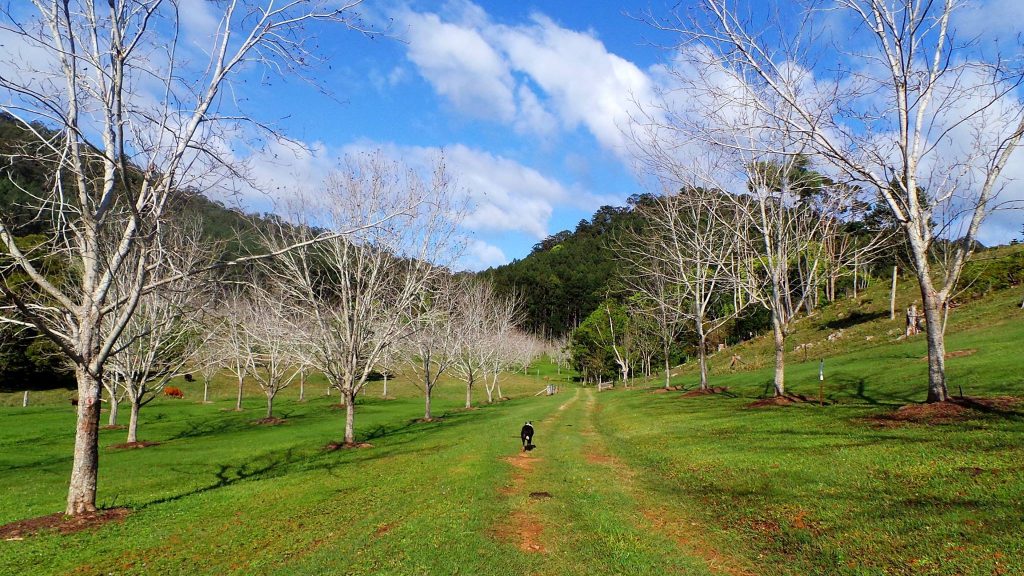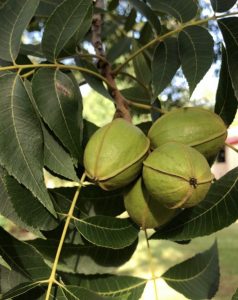
What’s News at the Market this Week?
This week Tweed River Pecans introduces their new product Pecan Crumbles. These are purely pecans buzzed into smaller pieces making them the perfect addition to pesto, crumble toppings, smoothies and nourishing bowls or simply a bowl of your favourite yoghurt. They add a delicious crunch with the bonus of some extra protein.
Kaye McNaught of Tweed River Pecans told me that she “ loves an apple crumble and what better addition than adding their new pecan crumbles to the topping.” Yummo!
So with Rhubarb in season right now who would love to make a rhubarb and apple crumble with Andy’s (Costanzo Apple Stall) Sundowner apples and Everest Farm’s or Summit Organic’s rhubarb topped with pecan crumbles (see photo above). Extra yummy!
So where is Tweed River Pecans and how do they grow these delicious nuts?
Tweed River Pecans is a family farm with 500 productive pecan trees that were planted in 1999. Grown in the fertile soils of the Tweed River Valley at Kynnumboon, Kaye and David McNaught are passionate about producing healthy and delicious pecans using biological farming methods.
Winter is a delightful time at the farm as these deciduous pecan trees lose their leaves creating a stunning vista of delicate silvery branches. And now is the time to really nurture the soil. Beautiful rich organic compost is spread across the entire orchard floor, clover – perfect for fixing nitrogen in the soil – flourishes. Their cattle are grazed in this are too adding more natural inputs to the biological life in the soil. It sets the orchard up well for the spring when – during October – the trees come alive again as buds swell and new foliage shoots out.
You will find Tweed River Pecans at Spice Palace where Rob from Spice Palace and Kaye from Tweed River Pecans will look after you.



What’s GREAT at the Market this Week?
We are shining the spotlight on chard/silverbeet this week.
Chard includes ruby chard, pink and orange stemmed varieties plus the pure white stemmed Swiss chard that we usually call silverbeet and the green stemmed silverbeet (available at Summit Organics).
When put together, all these different varieties are referred to as rainbow chard.
Here are some cooking tips from the book Magic Little Meals by Lolo Houbein and Tori Arbon:
- Silverbeet contains oxalic acid and as it is important not to have too much of this we can reduce it by blanching the leaves for 2 minutes in water and then discarding that water and rinsing. Now you can start cooking and here is another tip.
- Chop the chard and put in the saucepan with only the water left on the leaves from rinsing. Start off on low so as not to scorch the leaves and soon there will be enough water at the bottom too your pan o cook the vegetable to the softness you desire.
- Drain the water and stir in a raw egg until it disappears but binds the remaining juices. Add salt and pepper.
- A scraping of nutmeg lifts the flavour to gourmet standard. And if desired add a knob of butter or drizzle with olive oil.
Please see the recipe in our newsletter for another way to enjoy chard (silverbeet) and there are lots more so be adventurous and let us know what you enjoyed.
TURNIPS
Did you know that turnips – often considered a root vegetable – is actually a cousin of broccoli, brussels sprouts, kale and rocket? So like other cruciferous vegies turnips provide lots of nutrients while being low in calories. They are delicious mashed with lashings of butter and pepper and served as a base for casseroles but they are also delicious roasted. Or how about a parmesan crusted crushed turnip? This recipe by Carol Borchadt on her website From a Chef’s Kitchen was inspired by her rosemary and garlic crushed potatoes recipe. You can find this recipe at the link below. Or you might enjoy a simple creamy turnip soup – I hope the photo inspires you try a cook adventure with turnips.
As Yotam Ottolenghi says vegetables are full of flavour but you just have to work a little harder than you do with meat. So enjoy your veggies with a difference this week.

